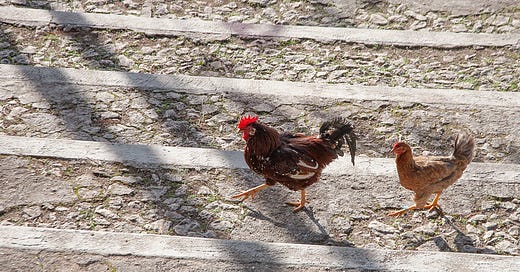Understanding Sharpness, Softness, Dimension, and Shadow in Photography
How Autofocus Points and Aperture (F-Stop) Settings Influence Sharpness, Softness, Dimension, and Shadow in Photography
Matthew Bamberg on Medium
All along, I thought the two chickens were the centerpiece of the shot above. I hadn’t studied the shadows. I perceived two dimensions. Then, voilà! I studied the shadows and wondered where part of them went, only to discover steps distorted them.
Shadow plays a vital role in your shots. It can enhance an image, from giving it added dimension to having it communicate added feeling. Shadows can disrupt an image, too. It can get in the way of what would otherwise have been a gorgeous shot. In the cover shot above, look closely. Shadow and dimension deceive. By studying the shadow, you’ll discover the dimension of the shot — the steps — change your composition.
Just as lighting can change from moment to moment, so can shadows. They can disappear when the sun goes behind a cloud, only to come back dark and unruly. Creating a compelling image with shadows takes time and experience, but once you know the tricks like the one described above, it’s easy to tame them to work well in your photography.
I begin the story, Dimension and Shadow, Soft or Sharp, with shadow removal. Unwanted shadows are pesky creatures that, today, are simple to eliminate.
If you’re shooting a landscape with your back to the sun in the late afternoon, there’s a good possibility that your shadow ends up in the frame. Sometimes you won’t notice that your shadow is in the way until you see the picture enlarged on your computer.
This is especially true if the landscape has vegetation in the foreground of your shot. The dark green of plants makes the shadow hard to see on an LCD screen, but you’ll find it there when you go home and download the image to your computer. In the beach landscape above my shadow interrupts the composition’s foreground.
To eliminate the shadow, I could have repositioned myself without my shadow cast in the frame, which would give me a landscape from a different angle than the one shown here. Your own shadow isn’t the only shadow that can be cast in the frame.
Sometimes, there are more options to eliminate shadows other than just moving to another spot or waiting for a different time of day to take the shot. In the first of three figures above, you see a ship’s shadow from a shot I took on a Caribbean cruise. Since the shot was taken on a partly cloudy day, I could have waited until the sun went behind a cloud, and the shadow would have disappeared.
The second way is in post-processing using Photoshop’s Generative Fill Tool. This AI (Artificial Intelligence) tool enables you to select the shadow and click on the generative fill option in the menu bar.
Keep reading with a 7-day free trial
Subscribe to Text and Image Substack to keep reading this post and get 7 days of free access to the full post archives.








